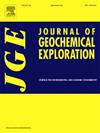Traceability of hydrological cycle in a closed inland lake basin: Insights from triple isotopes (δ2H, δ18O, δ17O)
IF 3.3
2区 地球科学
Q1 GEOCHEMISTRY & GEOPHYSICS
引用次数: 0
Abstract
Water stable isotopes are powerful tools for tracing hydrological cycle in lake basins, especially the triple isotopes (δ2H, δ18O, and δ17O). However, the application of the triple isotopes has lagged because δ17O was long considered invariant, too difficult to measure, or redundant to δ18O. The spatio-temporal variations of the triple isotope compositions in different water bodies within closed inland lake basins and their indications for hydrological cycle are still poorly documented. This study investigated the water sources, evaporation, and surface water-groundwater interactions in the Daihai Lake basin (a typical closed inland lake basin in northern China), based on the δ2H, δ18O, δ17O, d-excess, and 17O-excess in groundwater, spring water, river water, and lake water during the dry and wet seasons. The stable isotopes in river water and lake water were more enriched, while those in groundwater and spring water were more depleted. The atmospheric precipitation controlled by the westerlies and the East Asian summer monsoon is the main recharge source of the water bodies, but they were affected by evaporation after receiving recharge and showed seasonal variations. Under the influence of hydrogeological conditions, groundwater in the area around Daihai Lake (groundwater discharge area) occurred greater evaporation in the wet season, while the lake water had a large evaporation in the dry season under the effect of climatic conditions. The evaporation to inflow ratio (E/I) of Daihai Lake was 0.68 and 1.53 during the dry season and wet season, respectively, which proves that evaporation dominated the water loss from the lake. Additionally, there are close surface water-groundwater interactions in the study area, especially lacustrine groundwater discharge. This study provides deeper and more comprehensive insights into the application of the triple isotopes in the hydrological cycle, and contributes to improving the understanding of regional hydrological processes and water transport patterns.

封闭内陆湖流域水文循环的可追溯性:来自三重同位素(δ2H、δ18O、δ17O)的启示
水稳定同位素(δ2H、δ18O和δ17O)是追踪湖泊流域水循环的有力工具。然而,三重同位素的应用滞后,因为δ17O长期以来被认为是不变的,太难以测量,或者是δ18O的冗余。内陆闭合性湖盆不同水体三同位素组成的时空变化特征及其对水循环的指示作用文献较少。基于干湿季节地下水、泉水、河水和湖水的δ2H、δ18O、δ17O、d-excess和17O-excess,研究了中国北方典型内陆湖盆地岱海流域的水源、蒸发和地表水-地下水相互作用。稳定同位素在河水和湖水中较为富集,而在地下水和泉水中较为枯竭。西风带和东亚夏季风控制的大气降水是水体补给的主要来源,但补给后受到蒸发的影响,呈现季节变化。在水文地质条件的影响下,岱海周边地区(地下水排放区)的地下水在湿季蒸发量较大,而在气候条件的影响下,湖水在干季蒸发量较大。枯水期和丰水期,代海的蒸发入流比(E/I)分别为0.68和1.53,说明蒸发是主要的湖泊失水量。此外,研究区地表水与地下水之间存在密切的相互作用,尤其是湖相地下水的排放。该研究为三同位素在水循环中的应用提供了更深入、更全面的认识,有助于提高对区域水文过程和水输送模式的认识。
本文章由计算机程序翻译,如有差异,请以英文原文为准。
求助全文
约1分钟内获得全文
求助全文
来源期刊

Journal of Geochemical Exploration
地学-地球化学与地球物理
CiteScore
7.40
自引率
7.70%
发文量
148
审稿时长
8.1 months
期刊介绍:
Journal of Geochemical Exploration is mostly dedicated to publication of original studies in exploration and environmental geochemistry and related topics.
Contributions considered of prevalent interest for the journal include researches based on the application of innovative methods to:
define the genesis and the evolution of mineral deposits including transfer of elements in large-scale mineralized areas.
analyze complex systems at the boundaries between bio-geochemistry, metal transport and mineral accumulation.
evaluate effects of historical mining activities on the surface environment.
trace pollutant sources and define their fate and transport models in the near-surface and surface environments involving solid, fluid and aerial matrices.
assess and quantify natural and technogenic radioactivity in the environment.
determine geochemical anomalies and set baseline reference values using compositional data analysis, multivariate statistics and geo-spatial analysis.
assess the impacts of anthropogenic contamination on ecosystems and human health at local and regional scale to prioritize and classify risks through deterministic and stochastic approaches.
Papers dedicated to the presentation of newly developed methods in analytical geochemistry to be applied in the field or in laboratory are also within the topics of interest for the journal.
 求助内容:
求助内容: 应助结果提醒方式:
应助结果提醒方式:


